Town
| List of historic properties in Duncan, Arizona | |
|---|---|
| Town | |
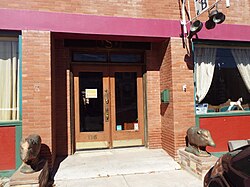 Simpson Hotel entrance- 1914 Simpson Hotel entrance- 1914 | |
 Location of Duncan in Greenlee County, Arizona Location of Duncan in Greenlee County, Arizona | |
| Coordinates: 32°43′33″N 109°5′52″W / 32.72583°N 109.09778°W / 32.72583; -109.09778 |


This is a list, which includes a photographic gallery, of some of the remaining historic buildings, houses, and other structures in the mining town of Duncan, which is located in Greenlee County, Arizona. The Duncan Pride Society has identified various structures as significantly historical. The society has taken it upon themselves the task of restoring many of them. Also included are photographs of the antique town clock and the 1950 Chevrolet 6400 2-ton fire truck once used in Duncan. Among the historic properties is the Benjamin F. Billingsley House, which is listed in the National Register of Historic Places.
Brief history
According archeologists the specimens of pottery and stone implements found in the area of Greenlee County, where the town of Duncan is located indicate that the members of the Anasazi were among the first people to inhabit the region. This was hundreds of years before the first white men, the Spanish explorers arrival. The Anasazi are considered by historians to have been an advanced ancient native-American civilization. Eventually the Apaches, who were hunters, gatherers, and raiders, would become the dominant native-American force.
New Spain
Francisco Vasquez de Coronado was a governor of a province in New Spain (in Mexico). He heard reports of the legend of the Seven Golden Cities and believed they were located north of Mexico's western coast. Vasquez de Coronado organized an expedition which eventually passed through the area where the San Francisco River is located. He failed in his mission. Fray Marcos de Niza, who was a notable Spanish missionary, also passed through the area with the intention of converting the natives to Catholicism.
New Mexico
The territory that includes present-day New Mexico and Arizona was designated as "New Mexico”. Mexico became independent from Spain in 1821. A team of mountain men and trappers that were led by James Ohio Pattie in 1824 and 1825 arrived, and they searched the San Francisco River edges for beavers in the area. Hats made from the fur of beavers were very popular in the 1800s.
In 1845, Mexico severed its relations with the United States because of the annexation of Texas by the United States. United States President James K. Polk declared war against Mexico in what became known as the Mexican–American War. The Mormon Battalion was among the troops which entered the area. Arizona north of the Gila River was taken by the United States under the terms of the Treaty of Guadalupe Hidalgo at the end of the war.
Arizona Territory
The California volunteers pursuing the Apaches in 185, discovered the first minerals in the Greenlee area. Conflicts between the Apaches and the advancing Anglo settlers resulted in a war known as the Apache Wars. The conflict with the Apaches lasted 26 years. Mining for gold and silver began in 1864, followed by copper in 1872.
Duncan had its origin on the north bank of the San Francisco River where two men, whose surname was Purdy, established a way station on the ore haulage line that ran between Clifton and Silver City, New Mexico. In 1883, a post office was established in Purdy. Thus the new settlement was named Purdy. Scottish investors financed the building of a narrow gauge railway from Clifton to Lordsburg, New Mexico. The railway line was called the Arizona and New Mexico Railroad, and it passed through Purdy. James Duncan Smith became the managing director of the Arizona Copper Company, and, after Purdy was moved to the south bank of the river, it was renamed Duncan. The Purdy post office was relocated to the new location of Purdy and thus the settlement was renamed Duncan. Duncan was officially founded in 1883 and became a shipping point for markets in the middle west and east. Zinc and copper mines were established in the hills around Duncan. The railroad stop in Duncan made the town a marketing center for farm produce and a shipping point for ore and cattle. Greenlee County was created in 1909 and named for Mason Greenlee, who was an early settler in the Clifton area.
Duncan Pride Society
The Duncan Pride Society was established on March 8, 2001. The society's vision statement is the following: "PRIDE is committed to work with our town government, community leaders and all area residents to preserve and enhance our town's overall image and historic value". The society's first project was Spezia Square, placed on a historical corner located on the Old West Highway. Among the society's accomplishments is the clean-ups and painting of scenes on most of the old buildings.
Jim McPherson, Arizona Preservation Foundation board president, has stated the following:
It is crucial that residents, private interests, and government officials act now to save these elements of our cultural heritage before it is too late.
An individual structure listed in the National Register of Historic Places (NRHP) is the Benjamin F. Billingsley House listed on August 25, 1983, reference: #83002998. The following is in accordance to the NRHP: Applicable Criteria: Architecture/Engineering Person; Architectural Styles: Queen Anne; Areas Of Significance: Commerce, Architecture; Periods Of Significance: 1900–1924 Sandra Day O’Connor, the first female justice of the United States Supreme Court, grew up on the Lazy B, a cattle ranch near Duncan.
Historic properties
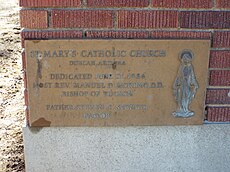
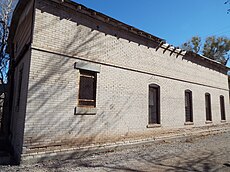
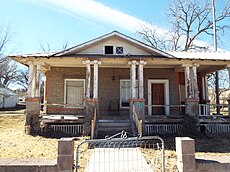
The following historic structures are listed as contributing factors within Duncan. The names posted are the original names used when the properties were first built. Also pictured is the antique town clock located in Spezia Square Park and the 1950 Chevrolet 6400 2-ton fire truck once used in Duncan.
- Benjamin F. Billingsley House – built in 1900 and located in 202 Main St. The Billingsley House is a one-story, slightly asymmetrical Queen Anne house with a steeply pitched, truncated hip roof. There is a corbelled brick chimney projecting from the south roof slope. Benjamin F. Billingsley, was a prosperous dry goods merchant in Duncan from 1895 to 1940. NRHP August 25, 1983, Ref: #83002998.
- Simpson Hotel (former Hotel Hobbs) – built in 1914 and located in 116 Main Street
- Freiheit Building – built in 1913 and located in Spezia Square Park on Railroad Ave. (Old US 70)
- Country Store – built in 1909 and located in 105 Railroad Ave. (Old US 70)
- Duncan Restaurant – built in 1909 and located in 107 Railroad Ave. (Old US 70)
- Duncan Theater – built in 1921 and located in Railroad Ave. (Old US 70)
- River Front Lounge (former Bonnie Heather Bar/Pool Hall) – built in 1925 and located in Railroad Ave. (Old US 70)
- Bonnie Heather Inn – built in 1920 and located in 105 Main Street
- First Duncan School Building – built in 1908 and located in 100 High St. Originally the school had a second floor. Now the American Legion, minus the second floor, which was removed, is housed in the building.
- Duncan Bus Station – now the Duncan Hotel was built in 1920 and located in 302 Old US 70
- Lonesome Dove Mercantile – built in 1860 and located in 404 North Ave.
- Saint Mary's Catholic Church – built in 1936 and located in 111 3rd Street
- Bank of Duncan – built in 1908 and located in 118 Main Street
- Duncan Opera House – built in 1920 and located in 218 Hill Street
- S & L Enterprises – built in 1896 and located in 108 Main Street
- Bart Tipton's Saloon (former Ford Motors, Peterson's Garage) – built in 1905 and located on the corner of Main and Railroad Ave
- Greenlee County Building – built in 1890 and located in 115 Madison Street
- House on 211 Railroad Ave. – built in 1920
- Germaine store – built in 1900 and located in 417 North Ave.
- Knights of Pythias building – built in 1900 and located in 449 (216) Main Street. This building housed the Duncan Lodge num. 27 of the Knights of Pythias
- Duncan Church of Christ – built in 1914 and located in 328 East Ave,
- Duncan Stage Stop – built in 1890 and located in Madison Street
- Antique town clock – located in Spezia Square Park on Railroad Ave. (Old US 70)
- 1950 Chevrolet 6400 2-ton fire truck – located on the corner of Main and Railroad Ave.
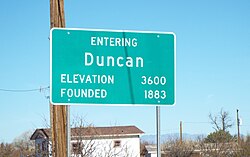
-
 Benjamin F. Billingsley House - 1900
Benjamin F. Billingsley House - 1900
-
 Simpson Hotel (former Hotel Hobbs) - 1914
Simpson Hotel (former Hotel Hobbs) - 1914
-
 Freiheit Building - 1913
Freiheit Building - 1913
-
 Country Store - 1909
Country Store - 1909
-
 Duncan Restaurant - 1909
Duncan Restaurant - 1909
-
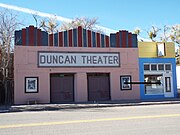 Duncan Theater - 1921
Duncan Theater - 1921
-
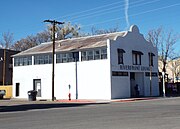 River Front Lounge (former Bonnie Heather Bar/Pool Hall) - 1925
River Front Lounge (former Bonnie Heather Bar/Pool Hall) - 1925
-
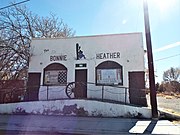 Bonnie Heather Inn - 1920
Bonnie Heather Inn - 1920
-
 First Duncan School Building - 1908
First Duncan School Building - 1908
-
 Old Duncan Bus Station now Hotel Duncan - 1920
Old Duncan Bus Station now Hotel Duncan - 1920
-
 Lonesome Dove Mercantile - 1860
Lonesome Dove Mercantile - 1860
-
 Saint Mary's Catholic Church - 1936
Saint Mary's Catholic Church - 1936
-
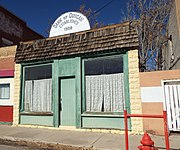 Bank of Duncan - 1908
Bank of Duncan - 1908
-
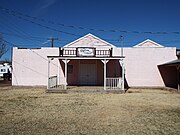 Duncan Opera House - 1920
Duncan Opera House - 1920
-
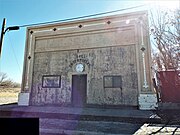 S & L Enterprises - 1896
S & L Enterprises - 1896
-
 Bart Tipton's Saloon - 1905
Bart Tipton's Saloon - 1905
-
 Greenlee County Building - 1890
Greenlee County Building - 1890
-
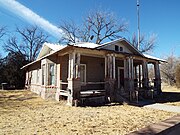 House on 211 Railroad Ave. - 1920
House on 211 Railroad Ave. - 1920
-
 Germaine store - 1900
Germaine store - 1900
-
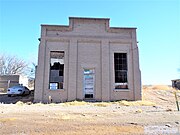 Knights of Pythias lodge #27 - 1900
Knights of Pythias lodge #27 - 1900
-
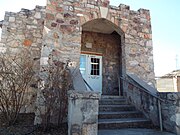 Duncan Church of Christ - 1914
Duncan Church of Christ - 1914
-
 Duncan Stage Stop - 1890
Duncan Stage Stop - 1890
-
 Antique town clock
Antique town clock
-
 1950 Chevrolet 6400 2 ton fire truck
1950 Chevrolet 6400 2 ton fire truck
Further reading
- Greenlee County; the Wonderland of Arizona; By: Phoenix Rush & Rush; Publisher : Franklin Classics; ISBN 978-0342582600
See also
References
- ^ Clifton's Colorful Past
- ^ Rich History; Clifton A Town Born of Chance
- ^ Native American Tribes & the Indian History in Clifton, Arizona
- ^ Greenlee County Library System
- Francisco Vasquez de Coronado
- Chisholm, Hugh, ed. (1911). "Marcos de Niza". Encyclopædia Britannica (11th ed.). Cambridge University Press.
- ^ Greenlee County, Duncan
- ^ Greenlee County History
- Mexican-American War
- Greenlee County; Clifton
- Duncan
- The Town of Duncan Duncan's Origins
- ^ Duncan Pride Society
- Arizona Preservation Foundation
- National Register of Historic Places
- Arizona's Women Hall of Fame
